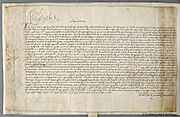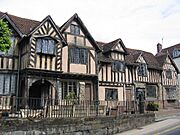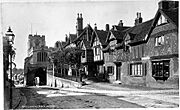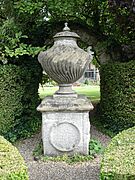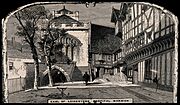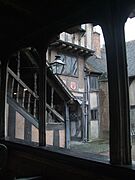Lord Leycester Hospital facts for kids
Quick facts for kids Lord Leycester Hospital |
|
|---|---|
| Chapel of St. James the Great | |
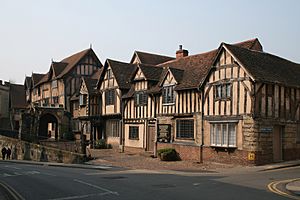
The Lord Leycester Hospital in Warwick, England.
|
|
| Location | Warwick, Warwickshire, England |
| Area | Warwick |
| Founded | 1571 by Robert Dudley, Earl of Leicester |
| Built | from 1126 to the late 15th century |
| Built for | The United Guilds of Warwick |
| Restored | Chapel restored 1860, accommodation restored 1966 |
| Restored by | Chapel restored by Sir George Gilbert Scott |
| Architectural style(s) | Medieval courtyard architecture |
| Governing body | The Lord Leycester Hospital (charity) |
|
Listed Building – Grade I
|
|
| Lua error in Module:Location_map at line 420: attempt to index field 'wikibase' (a nil value). | |
The Lord Leycester Hospital is a group of historic timber-framed buildings in Warwick, England. It is famous for being one of the best-preserved examples of medieval courtyard buildings in the country. It is not a medical hospital, but a home for retired soldiers. The word "hospital" comes from the old word for "hospitality" or providing a place to stay.
The buildings are located right next to the old West Gate of the town. For nearly 900 years, this spot has been important. The first building was a chapel built in 1126. Over the centuries, more buildings were added, creating the beautiful courtyard we see today.
Many famous people have visited the hospital, including writers like Charles Dickens and Oscar Wilde. It is a Grade I listed building, which means it is officially recognized as a very important historic site that must be protected.
Contents
History of the Hospital
How It All Began
The story of the Lord Leycester Hospital starts with a chapel. The Chapel of St. James the Great was built over Warwick's West Gate in 1126. In the 1300s, the 12th Earl of Warwick gave the chapel to a group called the United Guilds of Warwick.
Guilds were like clubs for skilled workers and business owners in the Middle Ages. They added more buildings around the chapel, like a Great Hall and a Guildhall. The Guildhall, built in 1450, was where the guilds held their meetings. The table in the center of the room is believed to be the original one they used.
A Home for Soldiers
In 1546, King Henry VIII broke up the guilds. The buildings were then used for town meetings and as a school.
In 1571, a very important man named Robert Dudley, the 1st Earl of Leicester, changed everything. He was a close friend of Queen Elizabeth I. He turned the buildings into a home for retired or injured soldiers and their wives. He called them the "Brethren." A "Master" was put in charge of the hospital.
In 1617, the Great Hall hosted a party for King James I when he visited Warwick. This event was so expensive that it left the town in debt for a long time!
Surviving the Great Fire
A major disaster struck Warwick in 1694. The Great Fire of Warwick started across the street and spread quickly. The strong wind pushed the flames through the town, destroying most of the old wooden houses. Amazingly, the Lord Leycester Hospital and a few of its neighbors survived the fire. This is why it remains one of the best examples of medieval architecture in the area.
The Hospital in Modern Times
The chapel was repaired in 1860 by the famous architect Sir Gilbert Scott. He added special supports called flying buttresses to make sure the chapel walls were strong. In 1966, the living quarters for the soldiers were updated, and Queen Elizabeth the Queen Mother attended the reopening ceremony.
Today, the hospital is still a home for retired soldiers, known as the Brethren. It is run by a Master, who is also a retired military officer. The Brethren help look after the buildings and act as tour guides for visitors.
What to See at the Hospital
The Chapel of St. James the Great
The chapel is known for its beautiful wood carvings. You can see the "bear and ragged staff," which is a famous symbol of Warwick. You can also spot a two-tailed lion, which was part of Robert Dudley's family crest. The stained-glass window was made by the famous Birmingham company, Clayton & Bell. Every weekday morning, the Master and Brethren still gather here for prayers, using the same words Robert Dudley wrote down nearly 450 years ago.
The Great Hall
The Great Hall looks much like it did in the 1300s. It was used by the guilds for big events and parties. Today, it is still used for dinners, concerts, and meetings. It gives visitors a real feel for what life was like centuries ago.
The Guildhall and its Treasures
The Guildhall is now a museum space. It displays many interesting historical items. You can see old weapons, like flintlock muskets (an early type of gun) and swords from the time of Napoleon. There is even a cannonball that was found at the site of the Battle of Edge Hill, a famous battle from the English Civil War.
The Master's Garden
In the Master's Garden, there is a special stone urn that is 2,000 years old. It came all the way from Egypt, where it was once part of a nilometer. A nilometer was a tool used by ancient Egyptians to measure the water level of the Nile River.
The Brethren
The retired soldiers who live at the hospital are called the Brethren. When you visit, you might see them in their traditional uniforms. They give guided tours and share stories about the hospital's long history. There is also a café on site called The Brethren's Kitchen.
The Hospital on TV
Because of its amazing historic look, the Lord Leycester Hospital is a popular place for filming movies and TV shows. It has appeared in productions like:
- Pride and Prejudice
- Tom Jones
- Moll Flanders
- Shakespeare & Hathaway: Private Investigators
- A Christmas Carol
- The Doctor Who episode The Shakespeare Code
Gallery


